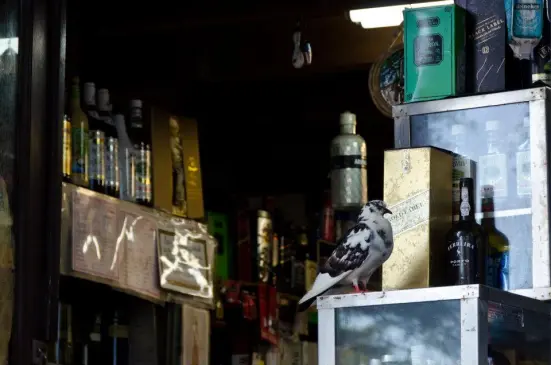A staple of many a far-off destination: the pigeon, always there to provide the familiar grey, the endearing vermin that keeps on spreading. I usually try not to catch one in a photograph, but they do sneak in. I will count them today.
In London, I caught the beginning of the end of the pigeon domination over the Trafalgar Square. As tense as the square was to run through then (it is a lot more conducive to human lounging now, I hear), it was certainly picturesque at its pigeonful heyday.
Warsaw’s colorful Old Town, meticulously reconstructed after it was razed to the ground by the Nazis, was another pigeon heaven. The birds kept me company as I waited by the square’s little mermaid, syrenka, the symbol and protector of the city, with a beautiful legend of her own. I heard that Old Town was particularly pigeon-friendly since the World War II: the Polish Resistance relied on carrier-pigeons to deliver important messages. In late 2000s, though, the city employed hawks to keep the pigeons in line–I wonder what the old market place looks like now.
If in Warsaw, pigeons blended in (although I think I’d notice if they were suddenly gone), I was stunned to find flocks of these birds in Western Cape. Pigeons were introduced to South Africa from Europe in 1800s, and flourished with a vengeance. Today, the country is home to the world’s largest pigeon race–a no laughing matter in Western Cape–the helpfully named South African Million Dollar Pigeon Race. Admittedly, against the immaculate white Dutch Cape gables and the bluest of skies in Stellenbosch, these birds looked more silver and aquamarine than boring-old grey.
Their Dutch counterparts spotted more earthy tones, perched above Groningen’s Sunday flower market. The picture below was taken as the bells of the Martinikerk rang over the town. Began in the 13th century, the church outlived lightnings (that burnt down two bell towers), changes in patronage (its intricately decorated ceilings endured the more austere times after the Spanish rule), and wars–the church and its distinctive stone tower survived the bombings that destroyed much of city center during the World War II.
On another side of the world, in São Paulo, Brazil, a pigeon and I listened to bells over Catedral da Sé, the largest cathedral in South America. The pigeon sat, intent, it seemed, on the scroll in a saint’s hand, peeking over the old man’s prodigious forehead. I will talk about my adventures at the cathedral at another time, but, truth be told, it is more impressive from the outside. I found São Paulo’s São Bento Monastery, and its Gregorian chants at daybreak, to be far more moving.
Pigeons are inevitable in New York and may even qualify as the city’s more charismatic fauna. They seem to love the Bethesda Fountain, one of my favorite Central Park spots as well. Fun facts: This is the only statue that was commissioned for Central Park, and its sculptor, Emma Stebbins, was the first woman to receive a public art commission in New York City.

Relaxing on the Angel of the Waters at the Bethesda Fountain. The fountain references the Gospel of John: “Now there is at Jerusalem by the sheep market a pool, which is called… Bethesda… whoever then first after the troubling of the waters stepped in was made whole of whatsoever disease he had.”
A sight less uplifting, pigeons seem to have developed quite a following for Central Park’s languid horses:
In the surreal Parque de las Palomas in the heart of Old San Juan, birds don’t have to steal others’ food. With a stunning view of the Bay, the park is always busy, full of children gleefully feeding the pampered vermin.

At Parque de las Palomas in Old San Juan (Puerto Rico), you can feed the pegions to your heart’s content

Apart from their intimidating numbers, I have to admit that many of San Juan’s pigeons are quite beautiful.
Speaking of pampered pigeons, Orlando’s Animal Kingdom has a stunning array of them in its Aviary. The alabaster Pied Imperial Pigeon was particularly striking.
The graceful turn of its head reminded me of our very own mourning doves, cooing soothingly in the back yard, my favorite place in the world, in the end.

And home again, where we rarely see pigeons in the back yard, but have a whole family of their local Virginia cousins: the mourning dove
Read on:







Pingback: Wistful Monday: A Morning in Stellenbosch « Transplanted Tatar
Pingback: Pigeons of Old San Juan « Transplanted Tatar
I love this idea of ‘pigeons across the world’! It probably sounds crazy, but I’m so often struck by how pigeons reflect the cities in which they live. Our NYC pigeons are always a bit grimy and rough around the edges, but I just came back from Charleston, and those southern vermin honestly seem to walk a little slower and stand just a *little* bit prouder. Strange. 🙂
Absolutely! This post came about after I came back from Puerto Rico, where pigeons are at pride of place–and sort of have their own charm. Then I looked through my pictures, and saw all these other pigeons. They do reflect a place, as generally grey and scruffy as they usually are.